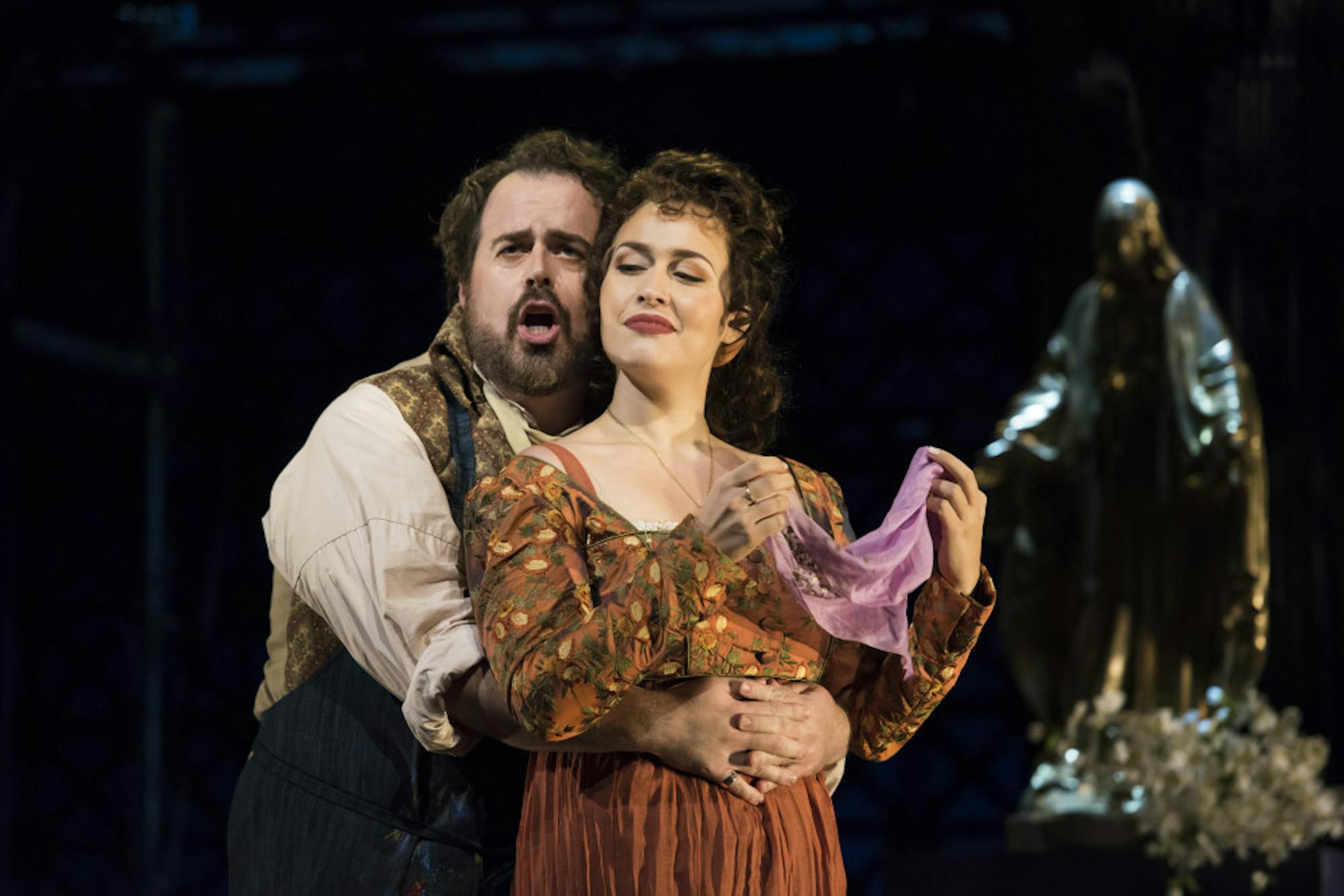Content Warning: This article mentions sexual violence.
“For myself the violent conquest has stronger relish than the soft surrender,” baritone Daniel Sutin croons in Italian, thirstily eyeing the striking, though currently distraught, auburn woman with whom he shares the stage. The audience audibly reacts, repelled by the villain’s lyrics, just one of many emotional responses elicited by the Boston Lyric Opera’s (BLO) sold-out opening night performance of Giacomo Puccini’s opera “Tosca” (1900) on Oct. 13 at the Emerson Cutler Majestic Theatre.
“Tosca” is a tale of political tumult and romance in Rome during Napoleon's invasion of Italy, but it is less a love story than the musical exploration of a complex heroine.
It is worth seeing BLO’s “Tosca” if only to hear Russian soprano Elena Stikhina make her American debut as Floria Tosca. The protagonist and singer, Tosca is arguably a more complex character than her male counterparts. Mario Cavaradossi is devoted to Tosca, but he is primarily focused on her physical appearance. Scarpia is a purely sadistic demon, and his complete lack of a single redeeming quality, while serving as the opera’s source of drama, makes him a simple antagonist. Tosca is initially presented as effervescent, a little bit petty, perhaps even vapid and certainly prone to fits of jealousy. As the opera unfolds, she grapples with issues of religious doubt, sexual assault, free will, autonomy and more, sometimes all at once.
We watch Tosca conflicted, defeated, furious, introspective and begging for mercy, but she is ultimately empowered. Stikhina captures this gradual unfolding of her character through the power of song, which poured from the stage and rushed over the audience in a wave of pure bliss. Her technical mastery was evident, but harder to pinpoint was the source of her voice’s timbre as it filled the hall with a warm glow. The famous “Vissi d’arte, vissi d’amore” aria marked the most sensitive moment of the production, during which Stikhina sustained a constant energy and wonderfully rich tone, even at her most vulnerable — reflective of Tosca’s determination to make her own choices until the lugubrious end.
The male leads provided a sufficient backdrop to Stikhina’s soaring execution. The Sacristan is a small role, but baritone James Maddalena’s treatment of it was noticeably weak in strength and projection. On the contrary, baritone David Cushing as Cesare Angelotti provided the strongest performance of the male singers. Right in the middle, tenor Jonathan Burton sung a respectable Cavaradossi. They blended well, especially in the unaccompanied duet near the opera’s end. In general, though, Burton could not help but be overshadowed by Stikhina’s remarkable vocal prowess. Sutin pulled off a convincing Scarpia in a similarly capable fashion.
Julia Noulin-Mérat’s clean and meticulously researched set designs complemented the plot without visually dominating the scenes. The intention to manipulate the stage less yielded a twofold benefit: The production avoided the anachronistic pitfalls that over-adaption can sometimes affect, while still presenting themes relevant to contemporary audiences.
In fact, BLO proved its ability to execute a unique and memorable production in other ways. Puccini’s score is the key to the opera's hallmark melodrama, and on Oct. 13 the opera orchestra was elevated 10 feet above the stage on a platform, which created room for 58 musicians in a space that normally fits a maximum of 35. There were no apparent acoustic consequences for this inversion of instruments and voice. An opaque screen was draped in front of the orchestra, leaving visible only the profile of conductor David Stern in his BLO debut. The relationship between Stern’s physical movements and the music’s aural presence provided the audience with another dynamic element to observe aside from the singers. The one drawback to this arrangement was that, because most conductors conduct ahead of the beat, Stern’s vigorous cues would sometimes give away the timing and character of what would otherwise have been an aural surprise, as a result undercutting the musical phrase’s impact.
Despite the formidable vocal chops of its performers, there is something that BLO does even better than sing: The company makes an unwavering commitment to reducing both cultural and financial barriers to opera accessibility. Its community outreach programs and innovative marketing far exceed those of peer organizations in the American opera and greater classical music worlds. High school and college students were invited to view the show's final dress rehearsal for free; the opera's Student Study Guide explained the fundamentals of opera and audience etiquette, identifying musical highlights to listen for in “Tosca”; and magazine articles such as “Get to Know Tosca in 5 Minutes or Less” provided a gateway to the stage for less experienced patrons.
And there are results: Last Friday’s performance welcomed over 100 attendees who had never seen an opera before, and a record number of PRIMA (BLO’s social group for young professionals) members were present, as was a hearty delegation from the Harvard Business School. Most orchestras and companies claim they understand the importance of attracting young people to the performance hall, but few are succeeding at BLO’s level.
Boston Lyric Opera's 'Tosca' combines convention, experimentation

Cavaradossi (Jonathan Burton) assures Tosca (Elena Stikhina) that he loves her in the Boston Lyric Opera production of Tosca, running Oct 13–22 at the Emerson Cutler Majestic Theater.
Summary
While not a revolutionary adaptation of the Italian classic, BLO's "Tosca" shines with strong vocal performances and unique orchestra arrangement.
4 Stars





